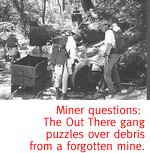
For Some Of The Best Mining, You Have To Venture Indoors.
By Kevin Franklin
IT HAS ALL the makings of an archeological detective story. Deep
within the forested mountain we find the ruins of a bygone era
of glory. The debris of daily life is strewn about, abandoned
in the rush to leave. A dark and cavernous maw cuts into the slope.
Water flows out of it from a spring somewhere deep inside. Like
some ancient hieroglyphic, a sign with a macabre Jolly Roger warns
us not to enter at risk to our lives. We peer inside and shine
our lights on the icy water and slimy mineralization of the old
mine. It's like an Indiana Jones movie.
 The place is marked on our map with a cartographic rune indicating
the mine, but there's no name or history.
The place is marked on our map with a cartographic rune indicating
the mine, but there's no name or history.
Hidden deep inside the Santa Rita Mountains, we wonder who worked
this place and when. There are piles of evidence: the remains
of an old steam engine, a mine cart, huge cast-iron pulleys. A
big pile of tailings is strewn outside the opening. But as for
anything distinctive, whoever worked this place took the story
with them.
One of the best places to look for history on mines or anything
geological is the Arizona Geological Survey. It's nice to know
your state tax dollars aren't all going toward redecorating the
governor's office.
"We're a state funded agency and open to the public,"
says AGS Geologist and Librarian Tom McGarvin. "Anyone interested
in legitimate research is welcome to come in."
Along with their large library, the AGS sells topographical maps
and books on mining and geology in Arizona.
McGarvin pulls out some yellowing books on mining history and
a stack of files for the area. The trail we'd started on was the
Vault Mine Trail. I thought perhaps it might be as easy as that.
I was wrong. After looking in the Index of Mining Properties
for Santa Cruz County and finding no reference to a Vault
Mine, I looked at old topographical maps. It turns out there is
a Treasure Vault Mine--on the other side of the mountain ridge.
So now I'm starting from scratch. Unearthing history on uninhabited
places can be something of a challenge.
"First of all, have a name and an accurate location,"
McGarvin says. "At that point we can start going into the
records and see if we have any information on it. Without a name
it can be a lot more difficult, unless you get lucky and find
it referenced in something like Shrader."
Frank C. Shrader was a geologist for the United States Geological
Survey who came through Arizona in 1915. His Mineral Deposits
of the Santa Rita and Patagonia Mountains is a classic and
invaluable text for area history. Unfortunately, it's out of print.
McGarvin pulls out one of his three copies--all of which look
like they went with Shrader on the original trip--for me to peruse.
 Gently leafing through the brittle pages, I feel like I'm examining
the Dead Sea Scrolls for the location of lost cities. Some of
the names in the book have changed since then. Stone Cabin Canyon
has become Florida Canyon. Even information on my 1981 topographical
maps has disappeared from my 1990 Santa Rita Recreation Map. A
few places Shrader mentions are nowhere to be found, and I try
to decipher their location from offhand remarks about streams
and mountains.
Gently leafing through the brittle pages, I feel like I'm examining
the Dead Sea Scrolls for the location of lost cities. Some of
the names in the book have changed since then. Stone Cabin Canyon
has become Florida Canyon. Even information on my 1981 topographical
maps has disappeared from my 1990 Santa Rita Recreation Map. A
few places Shrader mentions are nowhere to be found, and I try
to decipher their location from offhand remarks about streams
and mountains.
Eventually I find a description of one mine, The Little Shot
Mine, that is still on the modern maps. This is my Rosetta stone.
It allows me to orient myself to Shrader's directions and connect
my mystery mine with Shrader's Carrie Nation Mine.
Owned by the Tres Estados Mining Co., represented by C.W. Curry
of Tucson, the mine produced copper, lead and zinc at the turn
of the century. When Shrader passed through in 1915, 12 tons of
ore were ready for processing. The mine pierced the mountain for
350 feet, making it a small but respectable operation by mining
standards.
For those interested in mining for more mining history, the Arizona
Historical Society and the County Recorder's or Assessor's offices
might also have records of C.W. Curry and the Tres Estados Mining
Co.
It's all a matter of how much history you want to dig up. It's
not quite as profitable as digging for gold, but you do get to
solve a mystery once in a while.
Getting There
Arizona Geological Survey, 416 W. Congress St., Suite 100. Tucson,
Arizona 85701. Call 770-3500 for more information.

|





